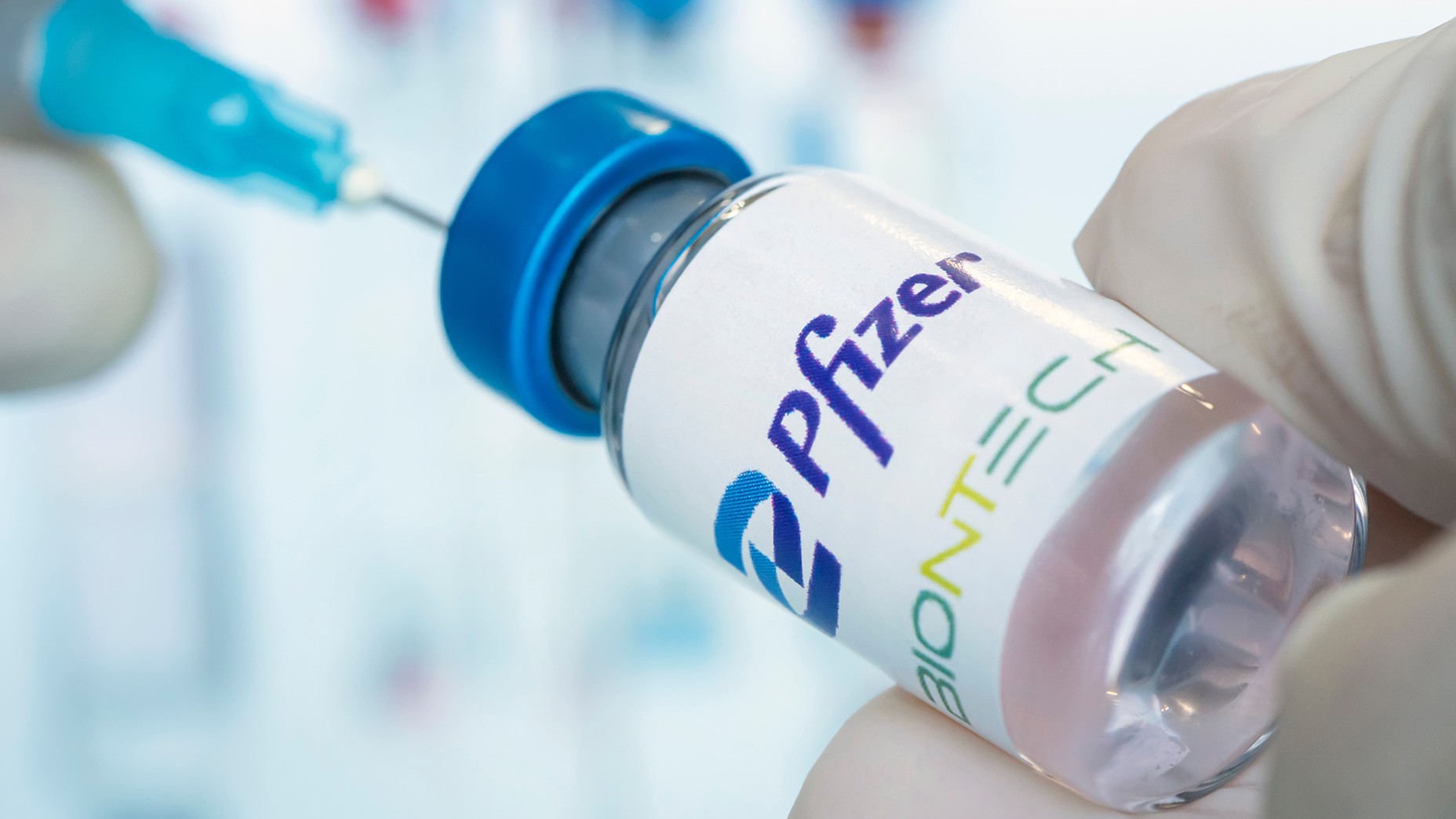Pfizer Stock Analysis: Navigating a 50% Drop in Two Years – Is Now the Time to Invest?

8 minutes for reading
Pfizer Inc. (NYSE: PFE) stock reached its high of 57.17 USD on 20 December 2021, after which it began a prolonged descent. On 13 December 2023, the quotes hit a low of 25.76 USD, indicating a 54.94% drop in the stock of the largest pharmaceutical company in two years.
Today, on 18 December 2023, we will analyse the reasons behind the decline in Pfizer Inc.’s stock value and assess the corporation’s future outlook. We will conduct a technical analysis of the stock and share experts’ 2024 forecasts.
Pfizer stock decline: analysing key factors
While the COVID-19 crisis proved detrimental to airlines, it propelled many representatives of the pharmaceutical sector to an entirely new level, including the company featured in this article. Pfizer Inc., in collaboration with BioNTech SE (NASDAQ: BNTX), developed a vaccine against coronavirus infection. In early December 2020, it became the first in the world to obtain regulatory authorisation for use, later supplying it to nearly all over the world.
This development positively impacted the company’s revenue, reaching 12.03 billion USD according to the Q1 2020 report and 25.66 billion USD based on the Q1 2022 report.
However, with other companies introducing COVID-19 vaccines, demand for Pfizer’s drug declined, negatively affecting the corporation’s finances.
Pfizer’s financial health: a detailed review
In its Q3 2023 report released on 31 October, Pfizer Inc. announced that:
- Revenue decreased by 41.55%, reaching 13.23 billion USD
- Net loss was 2.38 billion USD or 0.42 USD per share, while a year ago, net profit reached 8.61 billion USD or 1.54 USD per share
- Revenues from COVID-19 vaccines dropped by 70% to 1.31 billion USD
- Revenues from non-COVID-19 products increased by 10%
- Personnel layoffs and cost cuts of 3.5 billion USD are planned by the end of 2024
July to September 2023 losses became record ones for the pharmaceutical giant, with the previous quarterly loss of 580 million USD recorded in Q4 2019. The company’s management attributes this to COVID-19 inventory write-offs of 5.6 billion USD.
An additional negative factor is a sharp increase in the debt load in Q3 2023 of more than 87% to 61 billion USD, driven by the issuance of bonds for 31 billion USD to finance the purchase of Seagen Inc. However, it is important to note that even with the increased debt, the debt-to-equity ratio stands at 0.66.
An in-depth look at Pfizer’s failed weight loss drug impact
According to DataHorizzon Research, the market size of weight loss drugs was valued at 1.9 billion USD in 2022 and is projected to reach 82.8 billion USD by 2032. Pfizer Inc. intended to enter this market with its lotiglipron and danuglipron drugs. Two types of danuglipron were under development, with once-a-day and twice-a-day intake.
On 26 June 2023, the corporation announced that it discontinued the development of lotiglipron due to its potential negative effect on patients’ liver. It is worth noting that its development dates back to 2018.
Danuglipron trials started in 2021, with the medication delivering promising results during phase two trials and reaching the same efficacy as Ozempic, a popular drug from Novo Nordisk A/S (NYSE: NVO). However, on 1 December 2023, the company announced that it terminated clinical trials of twice-daily danuglipron due to strong side effects such as nausea, vomiting, and diarrhoea. At the same time, the company continued studies of the second type of danuglipron.
Pfizer’s growth post-Seagen acquisition: assets and opportunities
On 13 March 2023, Pfizer Inc. announced the acquisition of the American biotechnology company Seagen Inc., which specialises in developing drugs for cancer treatment, for nearly 43 billion USD. As early as 14 December, the parties reported the deal’s completion.
The acquisition of Seagen Inc. has provided Pfizer Inc. access to four drugs for treating various types of cancer, which have been approved by regulators and are available for sale, thereby likely strengthening its position in this market. Here below is the list of these drugs:
- ADCETRIS (lymphoma) – approved in more than 70 countries
- RADCEV (carcinoma) – approved in the US, EU, Canada, Australia, Japan, and South Korea
- Tivdak (recurrent or metastatic cervical cancer) – approved in the US and the EU
- TUKYSA (unresectable or metastatic breast cancer) – approved in the US, Canada, the EU, Australia, Singapore, and other countries
Pfizer’s future: promising drugs in the pipeline
According to Pfizer Inc.’s data, as of 31 October 2023, the company has 83 drugs in the pipeline, with 26 in stage one studies, 30 in stage two, 23 in stage three, and four under registration. These drugs are categorised into six groups: rare diseases/non-malignant haematology, anti-infectives, inflammation and immunology, internal medicine, vaccines, and oncology.
Oncology is the largest group by the number of drugs studied – 27, with twelve in stage one studies, five in stage two, nine in stage three, and one undergoing registration.
Pfizer Inc. is researching both the anuglipron and PF-06954522 drugs to enhance its prospects in the weight loss drugs market.
It is worth noting that fidanacogene elaparvovec, which is in the registration stage, has been granted a breakthrough drug designation by the Food and Drug Administration (FDA).
Pfizer’s dividend history and investor returns
Pfizer Inc. has been paying dividends to its shareholders for over 20 years. The yield was 8.53% in April 2009, with US deflation standing at 2.1%, and reached 9.47% in January 2021, with inflation at 1.4%. In December 2023, the dividend yield stood at 5.42%, with inflation at 3.1%. As we can see, the corporation aims to pay dividends higher than the inflation rate.
Despite Q3 2023 being loss-making, the Board of Directors approved a dividend payout of 0.41 USD per share and plans to increase the Q1 2024 dividend to 0.42 USD per share.
Depending on financial results, the pharmaceutical giant occasionally buys back its shares. According to Finance Charts, the last time was in Q1 2022, when the company repurchased shares worth 2 billion USD.
Current trends in Pfizer stock: an analytical overview
In March 2013, Pfizer Inc. stock surpassed the resistance level of 26.50 USD, which later became a support level. Since then, the shares have tested this mark six times but could not break it. On 13 December 2023, the quotes dropped back to the support at 26.50 USD.
A sharp increase in the stock trading volume may suggest that investors have started taking interest in them. In this situation, the price will likely rebound from the support level and rise to the nearest resistance at 33.00 USD.
Expert predictions: the future trajectory of Pfizer shares
- According to Barchart, six out of sixteen analysts rated Pfizer Inc.’s shares as a Strong Buy, one as a Moderate Buy, and nine as Hold, with an average price target of 37.19 USD
- Based on MarketBeat data, five out of sixteen experts assigned a Buy rating to the stock, while eleven designated a Hold rating, with an average price target of 40.35 USD
- As per TipRanks, six out of fifteen analysts gave a Buy rating to Pfizer Inc.’s stock, with nine rating it as Hold. The average price target is 34.25 USD
- According to information from Stock Analysis, three out of sixteen specialists assigned a Strong Buy rating to the shares, two gave a Buy recommendation, and eleven designated a Hold rating. The average 12-month stock price forecast is 40.38 USD
- Simply Wall St experts predict that the pharmaceutical corporation’s revenue and net profit will increase by 0.5% and 12.5% per annum, respectively. Return on equity is expected to reach 15.4% in three years
Given the above information, it is noteworthy that none of the experts covering Pfizer Inc.’s stock recommends selling the shares. On 18 December 2023, the share value reached 26.63 USD, with the average price target ranging from 34.25 to 40.35 USD.
Conclusion
After thoroughly examining Pfizer Inc.’s operations over the last few years, it can be assumed that a decline in the company’s earnings is expected. The COVID-19 vaccine enabled the corporation to capitalise on the pandemic. Nowadays, with a decrease in the number of global coronavirus cases and significantly lower demand for the vaccine, revenues from this drug sales have also dropped.
However, the positive trend persists: while revenues for Q1-Q3 2019 amounted to 39.05 billion USD, they reached 44.24 billion USD in the same period in 2023. Furthermore, revenues from non-COVID-19 products are gradually growing, and the company is aiming at personnel layoffs and cost cuts.
Based on the above information, it can be presumed that, in terms of its current prices, Pfizer Inc.’s stock appears attractive for long-term investments to receive dividends.
At the same time, history shows that investments in the company aiming to profit from stock value growth in the long term may fail to materialise. For example, if investors had bought the shares in 2013, they would have zero returns in December 2023.
* – The TradingView platform supplies the charts in this article, offering a versatile set of tools for analyzing financial markets. Serving as a cutting-edge online market data charting service, TradingView allows users to engage in technical analysis, explore financial data, and connect with other traders and investors. Additionally, it provides valuable guidance on how to read forex economic calendar effectively and offers insights into other financial assets.











